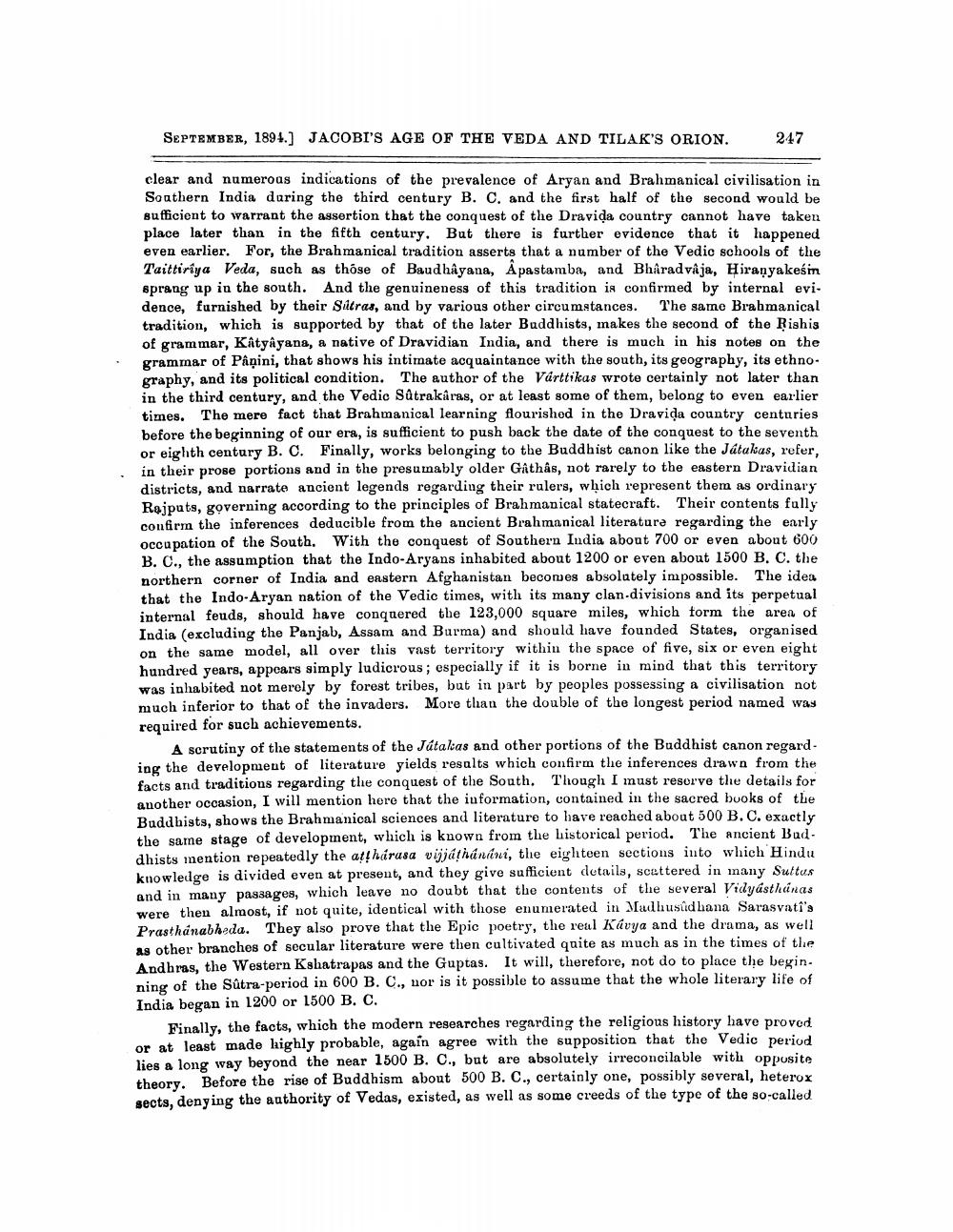________________
SEPTEMBER, 1894.] JACOBI'S AGE OF THE VEDA AND TILAK'S ORION.
clear and numerous indications of the prevalence of Aryan and Brahmanical civilisation in Southern India during the third century B. C. and the first half of the second would be sufficient to warrant the assertion that the conquest of the Dravida country cannot have taken place later than in the fifth century. But there is further evidence that it happened even earlier. For, the Brahmanical tradition asserts that a number of the Vedic schools of the Taittiriya Veda, such as those of Baudhayana, Apastamba, and Bharadvaja, Hiranyakeśin sprang up in the south. And the genuineness of this tradition is confirmed by internal evidence, furnished by their Sutras, and by various other circumstances. The same Brahmanical tradition, which is supported by that of the later Buddhists, makes the second of the Rishis of grammar, Kâtyâyana, a native of Dravidian India, and there is much in his notes on the grammar of Pânini, that shows his intimate acquaintance with the south, its geography, its ethnography, and its political condition. The author of the Varttikas wrote certainly not later than in the third century, and the Vedic Sûtrakâras, or at least some of them, belong to even earlier times. The mere fact that Brahmanical learning flourished in the Dravida country centuries before the beginning of our era, is sufficient to push back the date of the conquest to the seventh or eighth century B. C. Finally, works belonging to the Buddhist canon like the Játakas, refer, in their prose portions and in the presumably older Gâthâs, not rarely to the eastern Dravidian districts, and narrate ancient legends regarding their rulers, which represent them as ordinary Rajputs, governing according to the principles of Brahmanical statecraft. Their contents fully confirm the inferences deducible from the ancient Brahmanical literature regarding the early occupation of the South. With the conquest of Southern India about 700 or even about 600 B. C., the assumption that the Indo-Aryans inhabited about 1200 or even about 1500 B. C. the northern corner of India and eastern Afghanistan becomes absolutely impossible. The idea that the Indo-Aryan nation of the Vedic times, with its many clan-divisions and its perpetual internal feuds, should have conquered the 123,000 square miles, which form the area of India (excluding the Panjab, Assam and Burma) and should have founded States, organised on the same model, all over this vast territory within the space of five, six or even eight hundred years, appears simply ludicrous; especially if it is borne in mind that this territory was inhabited not merely by forest tribes, but in part by peoples possessing a civilisation not much inferior to that of the invaders. More than the double of the longest period named was required for such achievements.
247
A scrutiny of the statements of the Játakas and other portions of the Buddhist canon regarding the development of literature yields results which confirm the inferences drawn from the facts and traditions regarding the conquest of the South. Though I must reserve the details for another occasion, I will mention here that the information, contained in the sacred books of the Buddhists, shows the Brahmanical sciences and literature to have reached about 500 B. C. exactly the same stage of development, which is known from the historical period. The ancient Buddhists mention repeatedly the attharasa vijjáṭhánáni, the eighteen sections into which Hindu knowledge is divided even at present, and they give sufficient details, scattered in many Suttus and in many passages, which leave no doubt that the contents of the several Vidyasthanas were then almost, if not quite, identical with those enumerated in Madhusudhana Sarasvati's Prasthanabheda. They also prove that the Epic poetry, the real Kavya and the drama, as well as other branches of secular literature were then cultivated quite as much as in the times of the Andhras, the Western Kshatrapas and the Guptas. It will, therefore, not do to place the begin. ning of the Sûtra-period in 600 B. C., nor is it possible to assume that the whole literary life of India began in 1200 or 1500 B. C.
Finally, the facts, which the modern researches regarding the religious history have proved or at least made highly probable, again agree with the supposition that the Vedic period lies a long way beyond the near 1500 B. C., but are absolutely irreconcilable with opposite theory. Before the rise of Buddhism about 500 B. C., certainly one, possibly several, heterox sects, denying the authority of Vedas, existed, as well as some creeds of the type of the so-called




